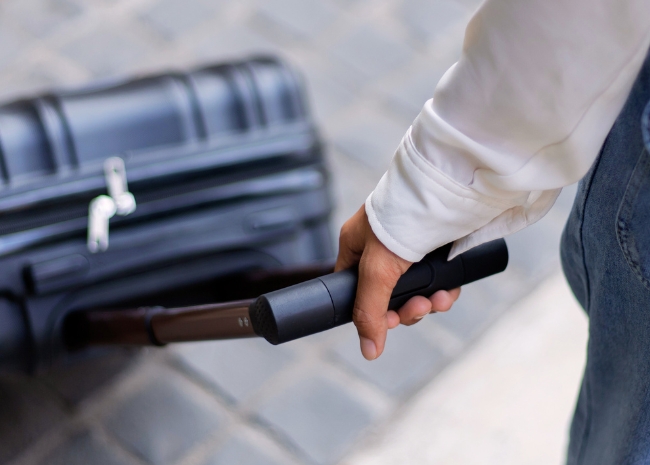
How To Lift or Carry Luggage Safely: Tips for Staying Injury-Free While Traveling
We’ve all been there—dragging a suitcase across a crowded airport, hoisting a carry-on into an overhead bin, or lifting a heavy bag into the trunk of a car. It seems simple enough, right?
But the truth is, lifting or carrying luggage the wrong way can easily lead to back pain, sore shoulders, or even a more serious injury.
So, how do you lift or carry luggage safely?
Let’s break it down into easy, real-life tips you can actually use the next time you pack up and hit the road.
1) Start with the Right Luggage
Before we even talk about how to lift luggage properly, let’s make sure you’re starting with a suitcase that works with you, not against you.
What to look for:
- Lightweight materials – the less your suitcase weighs when empty, the better.
- Four wheels (spinner style) – makes a huge difference when it comes to maneuvering through airports or streets.
- Multiple handles – having a top handle and a side handle gives you more options for lifting comfortably.
- Telescoping handle that adjusts to about waist height – that way, you’re not bending over awkwardly when you pull it.
These small features can make a big impact when you’re trying to move your luggage efficiently and safely.
2) Pack Smart, Not Heavy
Ever opened your bag and thought, “Why did I bring all this?” Yeah, we’ve all done it.
But smart packing isn’t just about saving space—it’s about making your luggage easier to lift and carry.
Here’s how:
- Put heavier items near the wheels so the suitcase stays balanced and easier to roll.
- Try to evenly distribute weight from side to side—lopsided bags are harder to carry and can throw off your balance.
- Use packing cubes or organizers to keep things in place and prevent sudden weight shifts when lifting.
3) How to Lift Luggage Properly (Without Hurting Yourself)
So now that your bag is packed and ready to go, let’s get into the meat of it: how to properly lift a suitcase without straining your back.
Here’s a quick step-by-step for safe lifting:
- Stand close to the bag – don’t lean forward or reach out.
- Bend at your knees, not your waist – this is huge. Let your legs do the work, not your back.
- Keep your back straight and your chest lifted.
- Grab the handles with both hands—it gives you better control.
- Lift slowly and smoothly—no jerking or twisting.
- Hold the suitcase close to your body as you stand up.
This is hands-down the best technique for lifting, whether you’re loading a bag into a car or onto a hotel luggage cart.
Lifting into Overhead Compartments? Do This Instead
If you’re wondering how to safely store your carry-on in the overhead bin, here’s a method that protects your back and shoulders:
- First, lift the bag to your seat or your knees—break it into two steps if needed.
- Then, push it overhead using both hands—don’t swing it up with one arm.
- Keep your feet staggered for balance, and don’t be shy about asking for help if it’s too heavy.
Trust us—lifting luggage safely is much better than nursing a shoulder strain halfway through your flight.
4) How to Properly Pull a Suitcase
Pulling your luggage seems like a no-brainer, right? But even that can cause strain if you’re doing it wrong.
Quick tips:
- Adjust the handle so it’s at waist height—you shouldn’t have to hunch forward.
- Push, don’t pull, if you can. Spinners are designed to be pushed smoothly beside you, which is easier on your body.
- If you’re pulling, switch arms every so often so you’re not overworking one side.
If you’ve been wondering how to properly pull a suitcase, the key is to keep good posture, move slowly, and keep the handle height comfortable.
5) Carrying Luggage by Hand? Here’s How to Do It Right
Sometimes you don’t have a choice—you’ve got to carry your bag up stairs or down a bumpy path.
Here’s the best practice for lifting and carrying luggage in those situations:
- Alternate sides if you’re carrying a duffel or shoulder bag for long periods.
- If you’re using a backpack, make sure both straps are on and it’s snug to your back—not hanging low.
- Keep heavy loads close to your center of gravity—it’s easier to control and puts less strain on your muscles.
And remember, if the bag is super heavy and you’re not sure you can handle it—ask for help.
Stretch and Strengthen to Travel Better
Even with the best lifting form, it helps if your body’s ready for it.
A little prep can go a long way toward avoiding pain.
- Stretch before and after your trip—your lower back, hamstrings, and shoulders especially.
- Do some core strengthening—planks, bridges, and bodyweight squats are great.
- Stay hydrated during your travels—tight, dehydrated muscles are more injury-prone.
If you’re traveling regularly, this kind of self-care is a game changer.
If You Do Feel Pain…
Sometimes you do everything right and still tweak something.
If that happens:
- Stop and rest—don’t keep lifting or carrying heavy bags.
- Apply ice to reduce swelling.
- Stretch gently to ease stiffness, but don’t push it.
- And if the pain lingers for more than a day or two, see a doctor or physical therapist—better safe than sorry.
Final Thoughts: Travel Smart, Lift Smarter
So, let’s circle back—how do you lift or carry luggage safely?
Here’s your quick recap:
- Choose lightweight, user-friendly luggage.
- Pack with balance and ease of movement in mind.
- Use proper lifting techniques (bend your knees, not your back!).
- Push your suitcase when you can; pull smartly when you must.
- Ask for help if the load’s too heavy.
- Listen to your body—if something feels off, stop.
Whether you’re heading out on vacation or just navigating a busy airport, knowing how to lift luggage properly and using safe lifting and carrying techniques can help you avoid the kind of travel injuries that ruin trips.
Safe travels—and safe lifting!
The Jackson Clinics serves 18 locations throughout Northern Virginia.
Find one near you: thejacksonclinics.com/locations









